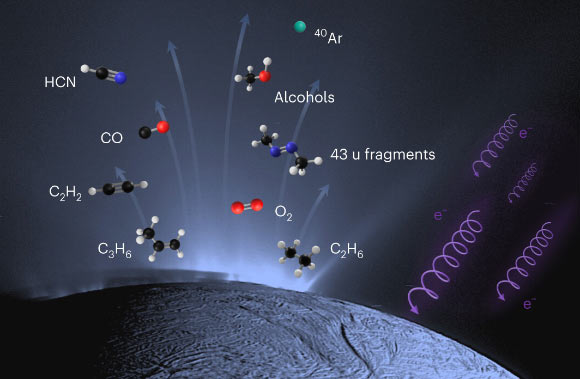Using data from NASA’s Cassini mission, planetary scientists have detected several compounds of strong importance to the habitability of Saturn’s icy moon Enceladus, including hydrogen cyanide, acetylene, propylene and ethane. These compounds could potentially support living microbial communities or drive complex organic synthesis leading to the origin of life.
Illustration of plume activity on Enceladus. Image credit: Peter et al., doi: 10.1038/s41550-023-02160-0.
“Our work provides further evidence that Enceladus is host to some of the most important molecules for both creating the building blocks of life and for sustaining that life through metabolic reactions,” said Jonah Peter, a doctoral student at Harvard University.
“Not only does Enceladus seem to meet the basic requirements for habitability, we now have an idea about how complex biomolecules could form there, and what sort of chemical pathways might be involved.”
“The discovery of hydrogen cyanide was particularly exciting, because it’s the starting point for most theories on the origin of life.”
Life as we know it requires building blocks, such as amino acids, and hydrogen cyanide is one of the most important and versatile molecules needed to form amino acids.
Because its molecules can be stacked together in many different ways, Peter and his colleagues refer to hydrogen cyanide as the Swiss army knife of amino acid precursors.
“The more we tried to poke holes in our results by testing alternative models, the stronger the evidence became,” Peter said.
“Eventually, it became clear that there is no way to match the plume composition without including hydrogen cyanide.”
In 2017, planetary scientists found evidence at Enceladus of chemistry that could help sustain life, if present, in its ocean.
The combination of carbon dioxide, methane, and hydrogen in the plume was suggestive of methanogenesis, a metabolic process that produces methane.
This process is widespread on Earth, and may have been critical to the origin of life on our planet.
Peter and co-authors uncovered evidence for additional energy chemical sources far more powerful and diverse than the making of methane.
They found an array of organic compounds that were oxidized, indicating to scientists that there are many chemical pathways to potentially sustain life in Enceladus’ subsurface ocean. That’s because oxidation helps drive the release of chemical energy.
“If methanogenesis is like a small watch battery, in terms of energy, then our results suggest the ocean of Enceladus might offer something more akin to a car battery, capable of providing a large amount of energy to any life that might be present,” said Dr. Kevin Hand, a researcher at NASA’s Jet Propulsion Laboratory.
Unlike earlier research that used lab experiments and geochemical modeling to replicate the conditions Cassini found at Enceladus, the authors relied on detailed statistical analyses.
They examined data collected by Cassini’s ion and neutral mass spectrometer, which studied the gas, ions, and ice grains around Saturn.
By quantifying the amount of information contained in the data, the authors were able to tease out subtle differences in how well different chemical compounds explain the Cassini signal.
“There are many potential puzzle pieces that can be fit together when trying to match the observed data,” Peter said.
“We used math and statistical modeling to figure out which combination of puzzle pieces best matches the plume composition and makes the most of the data, without overinterpreting the limited dataset.”
The findings were published in the journal Nature Astronomy.
_____
J.S. Peter et al. Detection of HCN and diverse redox chemistry in the plume of Enceladus. Nat Astron, published online December 14, 2023; doi: 10.1038/s41550-023-02160-0





